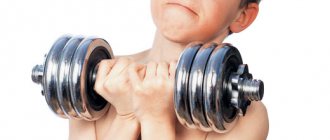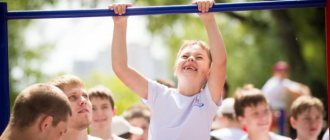Your child has grown up, become more active and independent, and you have decided to enroll him in one of the sports sections. However, you are faced with a difficult question - which one? After all, firstly, preschoolers are not accepted into all sections. Secondly, if you are guided by your preferences, you would be happy to send your child, for example, to hockey. But, unfortunately, your child is a girl! Or, for example, have you dreamed of playing chess all your life, but your son is too active and cannot sit still for five minutes? How to choose the right section for a child? This is what we will talk about today.
What sport is suitable for a boy 5-7 years old: types of sections, pros and cons
Review of sports sections for boys 5-7 years old: pros, cons
| Kind of sport | Who is this sport suitable for? | pros | Minuses |
| Figure skating The optimal age (if you want to engage in this sport professionally) is from 4 to 6 years. | This sport is suitable for almost all children who do not have a history of diseases such as flat feet, asthma, lung diseases, or myopia. You should not send children with a weak nervous system or vestibular disorders to the figure skating section. | This sport develops coordination of movements and flexibility. Strengthens ligaments and muscles. Improves the functioning of the cardiovascular and respiratory systems. Boosts immunity and improves blood circulation. The child becomes resilient and efficient. | This sport is considered traumatic. Figure skating is a rather expensive sport. As a rule, all equipment is purchased at the expense of the parents. |
| Swimming The optimal age to start is 4 to 5 years. | Suitable for almost all children. Of course, not everyone will become champions, but everyone will strengthen their nervous system and back muscles. Swimming is not recommended for children with cardiovascular diseases, skin diseases, viral infections, allergies, children with kidney failure It is not advisable to enroll children who have had seizures in the section. | Swimming will strengthen the immune system, improve blood circulation, and strengthen your child. Children who require a rehabilitation course after injuries and operations can be enrolled in this section. Swimming is an excellent prevention of all spinal diseases. | Chlorinated pool water can cause allergies. At first, it is possible that the child will get colds more often. Sometimes children develop chronic rhinitis. |
| Equestrian sport Horse riding can be done after 6 years of age. | Horseback riding is not recommended for children with heart disease, thrombosis, or diseases of the pelvic organs. “Hippodrome therapy” is widely used for therapeutic purposes after injuries and is recommended for children with cerebral palsy and children suffering from autism. | Horseback riding develops the muscles of the back and legs. Improves coordination. It has a powerful relaxing effect and has a beneficial effect on the nervous system. | There are practically no downsides. Perhaps the equipment is not too cheap. |
| Hockey Officially, boys over 5 years of age are accepted into the section. | Children with myopia, heart disease (congenital and acquired defects), and spinal diseases should not play hockey. | Playing hockey has a beneficial effect on the cardiovascular system, circulatory system, and improves immunity. Children who play hockey practically do not get colds, they are brave and sociable. | Hockey is a dangerous sport. Hockey lessons take a lot of time. Equipment for children is expensive. |
| Eastern martial arts The optimal age for starting martial arts is 6 years old. | This sport is contraindicated for children suffering from cardiovascular diseases, spinal diseases, vision problems and musculoskeletal problems. | Eastern martial arts allow you to gain the necessary self-defense skills and forget about all your fears and phobias. The child becomes bold and courageous. Thanks to classes, the child’s active physical development occurs and his immunity is strengthened. | There is a risk of injury. The right choice of trainer is important. |
| Acrobatics It is recommended to start classes at the age of 6-7 years. | Acrobatics classes are contraindicated for children with scoliosis or severe myopia. It is not recommended to enroll children suffering from epilepsy, heart disease, or asthma in the acrobatics section. | Acrobatics promotes the harmonious development of the body. Strengthens and normalizes metabolism. Allows you to get rid of clumsiness and trains the vestibular apparatus. Develops all muscle groups. | Risk of injury. As a rule, these are bruises, sprains, dislocations. |
Acrobatics
A sport such as acrobatics does not need advertising: we watch the tricks of professional athletes with admiration. From the outside it seems that everything is so easy and graceful, however, how many years of hard work, how many ups and downs are behind it! It is not at all necessary to make a professional acrobat out of a child, however, many elements of this sport will be useful for his harmonious growth, both physical and personal. Your child will be accepted into the section at the age of 7, but you should understand that this type of activity requires constant training - only under such conditions will the child develop flexibility, plasticity, coordination, and will become more resilient, purposeful and responsible.
What sport should a 5-7 year old girl participate in?
Sports for girls 5-7 years old
| Sports for girls | Who is this sport suitable for? | pros | Minuses |
| Rhythmic gymnastics Real rhythmic gymnastics classes begin at the age of 5-7 years. | Rhythmic gymnastics is not physical therapy, so children with excess weight and scoliosis will not be enrolled in this section. | Gymnastics perfectly disciplines children and provides general physical training. Rhythmic gymnastics strengthens the cardiovascular and circulatory systems, improves immunity, and stabilizes metabolism. This sport teaches you to listen and hear music and develops taste. The gymnasts have a beautiful figure, correct posture, and flexible movements. | Risk of injury. |
| Athletics It is officially believed that girls can start playing this sport at the age of 10. | Not recommended for: children with problems with the spine, heart, or respiratory system. | Harmonious muscle development, proper breathing, flexibility and agility. | A dangerous sport. |
| Swimming It is recommended to start classes at the age of 5-6 years. | There are no restrictions. | Swimming allows you to correct your posture, learn to breathe correctly, improves immunity, and improves blood circulation. | Chlorinated pool water can cause allergic reactions. |
| Tennis It is considered a one-sided sport. Therefore, it is recommended that girls start playing this sport no earlier than 11 years old. Otherwise, one side of the body will be developed more than the other. Of course, there are plenty of exercises to avoid this, but is it worth the rush? Girls can be enrolled in tennis at 4 and 6 years old. But these will be developmental and health-improving activities. | It is not recommended to send children with spinal problems, peptic ulcers, flat feet, or neurological diseases to tennis. | Tennis makes the body flexible, strengthens joints and the cardiovascular system. Develops flexibility, speed, and intuition in children. Tennis is a non-traumatic sport. | A financially expensive sport. Coaching sessions are expensive. |
| Figure skating From 4-5 years old, girls are willingly accepted into sections. | Girls with flat feet, neurological problems, poor eyesight, or pulmonary diseases should not be enrolled in the figure skating section. | Exercises can strengthen the immune system, increase endurance, and improve blood circulation. Figure skating improves the functioning of the respiratory and cardiovascular systems. | Expensive sport. Quite traumatic. |
| Chess You can start mastering the intellectual game at 4-5 years old. | There are practically no contraindications. However, a girl who is too active - an emotional choleric person - is unlikely to be carried away by sitting for a long time at the chessboard. | Chess develops in children such skills as: independence, perseverance, ability to analyze and make decisions. Excellent development of analytical thinking. | There are no cons. |
When choosing this or that section for your child, try to take into account all the features of his character and temperament. But remember, sport is simply necessary for the development of a healthy and harmonious personality.
Gymnastics and dancing
Gymnastics has a branched classification, however, we will focus directly on its sports variety - rhythmic gymnastics. When it comes to the question of what age to send a child to gymnastics, there is only one answer - the sooner the better: for girls - from 5 years old, for boys - from 6 years old. This is explained by the fact that children's bodies at this age are as flexible as possible, and sculpting Of these, stately boys and girls in the future are much simpler.
Upon entering the dance hall, your child will be required to undergo a short stretching test. A couple of simple exercises will help determine the degree of flexibility, as well as the psychological state and its readiness to perform complex tasks. The latter, by the way, is quite important, because gymnastic exercises, if performed incorrectly, are fraught with injury. You will notice the results of dance training very soon: the child will develop a sense of beauty, musical taste and straight posture.
Chess
A person who is capable of a successful game of chess is said to be an intellectual. And this is true, because before reaching heights in this sport, you should develop many qualities: perseverance, logical thinking, patience and perseverance. The minimum age at which your child will be accepted into the chess club is 4 years. For overly active and emotional children, this sport is unlikely to seem interesting, however, it has benefits for them too: the development of cause-and-effect thinking and the ability to concentrate on one thing.
First of all, chess is a workout for both hemispheres of the brain. Both creative thinking and cold calculation are important here. In addition, the game teaches discipline, which is useful for preschool children: it is quite possible that in the future they will have practically no comments on their behavior in the diary.
Fencing
Perhaps fencing is one of the most graceful and noble sports. He will teach the child to control himself and not give way to emotions: the rules of the fight must be observed, because it is fought with the use of weapons. If you see that your child is already able to act according to a certain sequential pattern and does it quickly, then at the age of 6-8 years he can be enrolled without a section.
This sport belongs to the group of universal ones: both girls and boys can achieve unprecedented heights in it and, in addition, compete against each other. During the next game, the child is always concentrated, working not only physically, but also mentally. His task is to figure out weaknesses and develop his own tactics.
Cycling for children
You can master the first type of transport in your life from an early age, however, you should start with a three-wheeled or four-wheeled one. In the art of riding any bicycle, several basic skills are important - braking, balance and knowledge of the rules of the road: the child must understand that riding on the roadway is strictly prohibited. From the age of 8, you can already think about switching to a two-wheeled friend, but before that you should take care of equipment in the form of a helmet, knee pads and elbow pads.
Cycling is a universal form of physical activity for both boys and girls. Of course, at first you cannot do without bruises and abrasions, however, a toned body, endurance and the ability to maintain balance will be an encouragement. Training takes place in the fresh air, which has a positive effect on the functioning of the cardiovascular and respiratory systems. You will soon notice that your child begins to get fewer colds, and this is thanks to cycling!
Horseback riding
A sport such as horse riding can solve a number of parental problems: discipline a child, cultivate love for our smaller brothers, teach the rules of behavior in society and help physical development. Children are given horse riding at the age of 5-6 years, however, everything depends on the child’s height: while in the saddle, he should easily reach the stirrups.
Equestrian sport is one of the most expensive, so it would be a shame to spend money and then hear a categorical “no” from your child. It's easy to test your passion for horses thanks to open stables, children's parks and zoos. Taking into account all the dangers of horse riding, it is impossible not to appreciate the influence of these noble animals on the child’s psyche: it is not for nothing that hippotherapy is one of the most effective medical methods for maintaining mental health.
Basketball
Another collective sport that develops physical and mental components. It is worth sending your child to it when he learns to multitask and solve non-standard issues that require a non-standard solution. Therefore, the optimal age is 8-9 years.
Like any other team sport, basketball makes a child sociable and adapted to society. The benefits for maintaining physical fitness are obvious, however, the development of motor skills, perseverance and coordination of movements is important. When you enroll your child in a basketball class, you shouldn’t immediately expect him to shoot the ball into the basket like Michael Jordan. Be patient: the first few years will be spent learning how to handle the ball and serve.
Martial arts
Many parents do not want to send their children to martial arts classes, believing that they instill cruelty in them. This opinion is erroneous, because martial arts is not just a sport, but an entire culture, the intricacies of which a child can begin to learn at the age of 4-6 (if we are talking about Wushu or Aikido). The older he gets, the more types of martial arts open up to him. Among them are judo, karate, taekwondo, and others - they are available from 9-12 years old. You can send children to boxing from the age of 12-14 - such a clear gradation is explained by the fact that each age category has its own degree of physical development. Injuries caused to fragile ligaments and joints during a boxing round can negatively affect further development.










